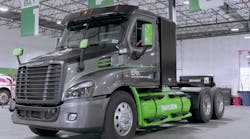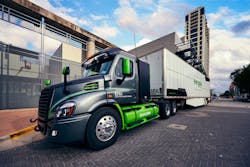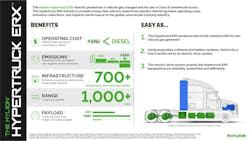Heavy-duty fleets have a lot to figure out over the next decade as they tackle sustainability goals while still fulfilling customer needs, from what type of truck to use to how to power them. Soon next-generation powertrain provider Hyliion may be able to provide more clarity on both, as its newly launched Hypertruck Innovation Council begins to validate and stress test the Austin-based company’s Class 8 natural gas/battery-electric solution.
The Hypertruck ERX (Electric Range Extender), expected to begin production in 2022, leverages an RNG/CNG fuel tank and generators, a battery pack and Dana motors, inverter and e-axles, to provide an average range of 1,000 miles per tank, and 25 miles of battery power to operate in zero-emission zones. Dana will also provide the manufacturing for the Hypertruck powertrain, which will go on the truck at the OEM.
Hyliion's council comprises 11 members, including leading for-hire fleets such as Penske, Ryder, Schneider and Werner Enterprises, and private fleets Anheuser-Busch and Wegmans. In total, the fleets operate 100,000 Class 8 trucks around the globe in primarily on-highway applications, and their experiences and insights are expected to uncover if the Hypertruck is more than just hype.
“These fleets are going to be part of the development cycle,” said Hyliion founder and CEO Thomas Healy. “They're going to be giving us feedback, what they like, what they don't like, and give us the do’s and don’ts of how we design and architect our product, so that when we deliver it to them, we've already got the customer in mind.”
The full list of members is as follows:
- Agility Logistics
- American Natural Gas
- Anheuser-Busch
- GreenPath Logistics
- NFI
- Penske Truck Leasing
- Ruan Transportation Management Systems
- Ryder System, Inc.
- Schneider
- Wegmans Food Markets
- Werner Enterprises
Healy said future customers would be any fleet that operates outside of the approximately 100-mile radius of battery-electric trucks and doesn't want to wait several years for hydrogen-powered options currently being developed .
“Once you start getting more than that, that's where we see going to this Hypertruck ERX, where it's effectively an electric truck, but we're utilizing an onboard generator to produce the electricity. That's where we kind of fall into being the logical power train solution,” Healy said.
Meanwhile, a seat on the council presents these member fleets another potential solution to address their corporate sustainability goals now, rather than waiting for BEVs to improve range or for fuel-cell electric trucks (FCETs) and hydrogen infrastructure to mature.
“The most impactful technologies come from close collaboration with experienced and innovative minds, and we’re excited to participate in the Hyliion Hypertruck Innovation Council to support the development of a transportation solution that meets the complex needs of today’s fleets while working to build a more sustainable future,” said Angie Slaughter, vice president of sustainability and logistics procurement at Anheuser-Busch.
With RNG, the Hypertruck can provide carbon-conscious fleets with a net-negative emissions solution.
“About 40% of the [natural gas] fuel use today is already coming from RNG,” said Healy, who pointed out more are routinely coming online. About 700 heavy-duty natural gas stations are spread out across the nation, which will be enough to support Hypertruck fueling needs.
“It's just we'll get more of them when the volumes [of natural gas trucks] start picking up,” he said.
As RNG grows in usage, this allows the carbon credit economy to reduce fuel costs even more.
“As a fleet owner or operator, you get to track how much RNG you use from an emissions reduction standpoint, but thankfully, the fuel providers actually take care of all the selling of credits,” Healy said. “That's taken care of upstream, and fleets reap the benefit of having a lower cost per gallon at the pump.”
Fleets will also benefit from the regenerative braking capabilities. The motors, not the foundational brakes, act to slow the truck, with the kinetic energy converted to electrical energy stored in the battery. This also reduces wear and tear on the pads and rotors.
The hydrogen dilemma
Hydrogen trucks will offer zero emissions and expected to provide a range nearer to the Hypertruck’s, though practically that entire infrastructure network is currently nonexistent. A functional hydrogen truck fueling network needs about 500 to 700 stations, Healy said, who added Hyliion is “pro-hydrogen.”
“On our roadmap, we plan on having a hydrogen-fuel-cell vehicle and fuel agnostic vehicle that can run on either natural gas or hydrogen.”
Healy said besides infrastructure, two other needs must be met for fuel-cell trucks to become feasible. One is bringing hydrogen costs down from $16/kg down to $2 or $3/kg, and the other is producing hydrogen from renewable sources.
“What often doesn't get discussed is over 90% of the hydrogen made today is actually dirty hydrogen,” Healy said. “It's more polluted than a diesel truck, so we need to get a lot of clean hydrogen coming from renewable sources.”
There are at least eight various ways to produce hydrogen fit for heavy-duty trucks.
In the long term, Healy expects these hurdles to be overcome. The question is when.
“I fully expect within this decade, we're going to have low volume rollouts of hydrogen,” Healy said. “The problem is we're not going to have high volumes until those three things happen. And it's kind of anyone's guess how long that's going to take.”
Healy said the Biden administration’s proposed $2.2 trillion infrastructure bill, the American Jobs Plan, which earmarks $174 billion for EV adoption, could help Hyliion and its partners, though the company can succeed without government handouts.
“In order to be successful, we're not reliant on a government subsidy,” Healy said. “The reality is hydrogen, and many BEV applications only work when there is a government incentive right now. With our Hypertruck using renewable natural gas, it can work on its own two feet right out of the gate. Any of the incentives we and fleets can potentially take advantage of are just the upside to the company's potential.”






